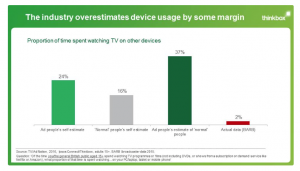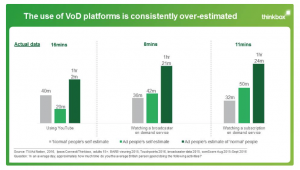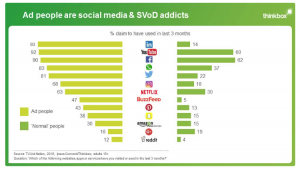Ad industry out of touch with media habits
The dominance of digital media and the demise of TV is a common theme in the marketing press and at conferences. But it seems the advertising industry is abysmal at understanding the media habits of real people, according to the ‘Ad Nation’ study conducted recently by Thinkbox with IPSOS. This study asked 300 members of the advertising industry about their estimates of the viewing habits of the British public and compared these guesses with the responses from 800 nationally representative UK residents aged 15+. Below I share the headlines from the study.
1. Most people still watch TV on TV
The research showed “how abysmal the industry is at estimating viewing time of the general population”. Ad people estimate that ‘normal’ people spend a whopping 37% of their TV viewing time on a device other than a TV (mobile phone, laptop etc.). The real figure is a measerly 2%, based on analysing a mix of BARB and broadcaster data.

2. Online video is still in its infancy for normal people
Misperceptions are particularly profound when it comes to estimating the time spent watching YouTube and Video On Demand (VoD). Ad folk estimate that the general population watch a whacking 1 hour and 21 minutes of Broadcaster VoD content per day (this is things like BBC iPlayer). Broadcaster data shows that ad folk have over-estimated this by over ten times: the real number is just 8 minutes per day. This mis-estimation is repeated in estimates of subscription VoD (e.g. Netflix), where the ad industry feel the UK public watch 1 hour and 24 minutes per day when Touchpoints puts the real number as just 11 minutes. YouTube estimates follow exactly the same pattern.

3. Ad folk have very different media habits
So how come ad folk are so wide of the mark in understanding ‘real people’ and their media habits? The Ad Nation study suggests that the problem comes from ad people simply projecting their own habits onto other people and mistakenly assuming everyone is like them. In reality, “ad people are hopeless social media and subscription VoD addicts,” explains the study, being generally educated, upmarket, London-centric and time-poor. Compared to the general population, ad people are 4 x more likely to have used Twitter within the last three months, seven times more likely to use LinkedIn usage and more than twice as likely to have used Netflix or Amazon Instant Video.

Conclusions
The first conclusion is to avoid falling for the hype and headlines that claim the demise of conventional media like TV. Digital and social channels are of course important, especially for younger consumers. But be sure to base your media plan on a thorough, data-based understanding of real peoples’ habits, not on what your agency team think.
Second, this is a reminder to immerse yourself in the real lives of your consumers, and avoid projecting your own habits and beliefs onto them.

